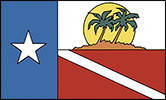Don’t think you’ll ever dive at altitude?
If you’re like us you’ll dive everywhere you can. Even after a heavy rain you see a puddle and instantly want to don your dive gear. Perhaps you’re taking a weekend trip to Balmorhea State Park or Blue Hole in Santa Rosa. Or, you’ve joined in on the adventurous dives in the Valhalla Missile Silo outside of Abilene. In any of these situations, besides the rain puddle that is, you will be diving above 1,000ft. For this reason, you want to have the proper training to safely execute these dives. Like the training you will receive in your PADI Altitude Diver course.
How is altitude diving different?
The surface pressure is different above 1,000ft than it is on our Caribbean dives for which we trained. Most of our dive calculations we learned in our regular scuba classes are based on the pressure at sea level. Our stop times and decompression limits will be different up n the mountains than they are down in Cozumel. This means we have to plan our dives a little differently to adjust for those differences. Coincidently, the PADI Altitude Diver course was designed to teach you how to do just that!
So if you are thinking of a dive in Licancabur Lake, this course is for you.

How your Altitude Diver course works
In your Altitude Diver course you will learn the differences of diving at higher elevations. During your class you will perform two dives at altitude under the supervision of a PADI Altitude Diver Instructor. The first dive of this PADI Specialty Diver course may count as an Adventure Dive toward your Advanced Open Water Diver certification.
Also, you will spend some dry time learning about diving at altitude. Some of the things you will discuss are altitude dive planning, organization, procedures and techniques. You will learn how to adjust your dive computer for diving at altitude and go over tables (because some of us are still afraid of technology). Finally, we'll talk about problems that may arise with this type of diving and how to prevent and handle them. When the class is completed, you will be equipped with the knowledge to begin your training for your dive at Ojos del Salado, in Chile!
